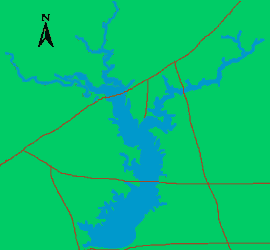Fishing
- Licenses & Regulations
- ShareLunkers
- Fish Identification
- Fish Consumption
- Texas Freshwater Fisheries Center
Water Resources
- Texas Reservoir Levels
- US Army Corps of Engineers
- Texas Water Issues
- Golden Alga
- Aquatic Vegetation
PO Box 116
Mathis, Texas 78368
(361) 547-6222, dial 5 Ext:241
Dusty McDonald, Biologist
Local Information
- Brackenridge Recreation Complex
891 Brackenridge Parkway
Edna, Texas 77957
(361) 782-5456
Lake Texana
Quick Links: Fishing Regulations | Angling Opportunities | Cover & Structure | Tips & Tactics
Lake Characteristics
Location: Jackson County, eight miles east
of Edna, Texas on US 59
Surface area: 9,727 acres
Maximum depth: 58 feet
Impounded: 1980
Water Conditions
Current Lake Level
Conservation Pool Elevation: 43.99 ft. msl
Fluctuation: Fluctuation: High and frequent, 5-10 feet
Normal Clarity: Stained to muddy
Reservoir Controlling Authority
Lavaca-Navidad River Authority
PO Box 429
Edna, Texas 77957
(361)782-5229
Aquatic Vegetation
Lake Texana contains many native and exotic species of aquatic vegetation. Large stands of water hyacinth are present throughout the reservoir. Moderate densities of giant salvinia, hydrilla, coontail, spikerush, cattail, pondweed, and bulrush are also present. Please help prevent the spread of these exotic plants by cleaning all vegetation from boats and trailers before launching and after recovering boats from Lake Texana.
Predominant Fish Species
Lake Records
Current
Fishing Report
Stocking History
Latest Survey Report
Lake Maps
Detailed fishing maps are commercially available at most local bait and tackle dealers.
Fishing Regulations
All species are currently managed under statewide regulations.
Angling Opportunities
Blue catfish and largemouth bass are the most popular sportfish in the reservoir. Blue catfish are abundant with frequent reports of large stringers. Flathead and channel catfish also provide noteworthy fisheries. Fishing for largemouth bass has improved in recent months. White bass provide excellent angling opportunities in the Navidad and Sandy Creek channels during the cooler months and in the main reservoir near the dam during summer. Although crappie fishing can be tough in the summer, respectable catches are not uncommon during the spring.
| Species | Poor | Fair | Good | Excellent |
|---|---|---|---|---|
| Largemouth Bass | ||||
| Channel Catfish | ||||
| Blue & Flathead Catfish | ||||
| Crappie | ||||
| White Bass | ||||
| Sunfish |
Fishing Cover/Structure
Lake Texana contains vast floating beds of water hyacinth which provide marginal habitat for most sportfish species. Isolated beds of hydrilla, coontail, and other submerged aquatic vegetation provide the best habitat for largemouth bass. Most of the reservoir contains submerged timber and numerous stumps, ideal structure for catfish species. In periods of high water, flooded terrestrial vegetation provides excellent habitat for all game fish species. The Navidad River channel and the adjacent shallow area called the "jungle" is a favorite bass fishing area, water level permitting.
Use the Habitat Structure Viewer for an interactive map of fish habitat structures and downloadable GPS coordinates.
Tips & Tactics
Catfish anglers utilize juglines and trotlines in their pursuit of flathead, blue, and channel catfish. Rod and reel anglers often fish creek channels and submerged terrestrial vegetation, water level permitting. Popular baits for catfish include stinkbait, cheesebait, live sunfish or shad, and cut bait.
Largemouth bass anglers prefer spinnerbaits, buzzbaits, jigs,
Texas-rigged soft plastics, and tube baits in either dark or white and chartreuse
colors. Working any visible laydowns, submerged brush, and vegetation in or
near deeper water (5 feet or more) is a popular tactic for largemouth bass.
Shallow gravel bars near creek channels are often productive when found near
a dropoff or steep bank.
Crappie anglers concentrate on the edges of water
hyacinth in the creek channels during the spring, dabbling small white,
pink, or
black and chartreuse crappie jigs near shore. Submerged brush in 4-5
feet of water within a creek channel is often an overlooked holding
area for large crappie in the spring.
White bass concentrate in the Navidad River and Sandy Creek channels in December and January in preparation for their annual spawning "run" and can be caught using small rattletraps, inline spinners, minnow imitating jigs, and live minnows under a bobber. The most effective artificial baits during this period are white or chrome in color. Locating schooling fish on a depth finder and fishing live bait at the correct depth may prove more productive.
